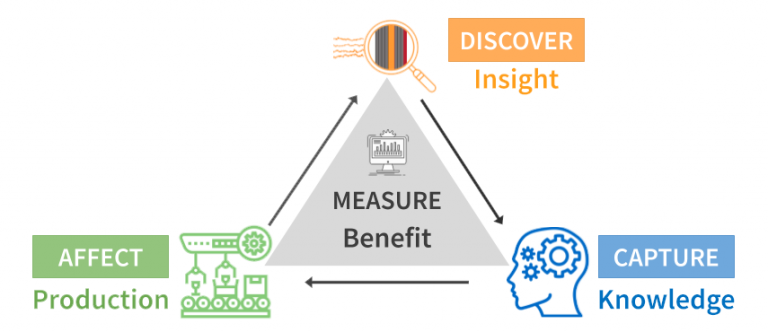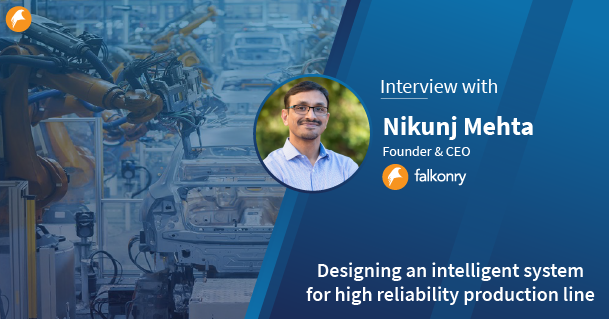AI-enabled Operational Excellence
Key Takeaways:
- Successful digitization of manufacturing and production operations will result in taking Operational Excellence to the next level.
- Falkonry's approach to AI-enabled operational excellence is applicable across industry segments and problem areas.
- The main benefit of Falkonry’s approach is it enhances knowledge capture, speeds up decision making and process improvement, and reduces transformation risks.
There are strong organizational synergies to pursue Digital Transformation and Operational Excellence together rather than separately. The big organizational challenge with digitalization efforts is the difficulty transitioning from strategy to innovation to adoption. In our experience, the route between innovation and adoption is the trickiest to navigate and operational excellence teams manage this transition all the time. Therefore, we find the best adopters are companies that have a strong operational excellence strategy and successful operational excellence leaders and practices.
AI-enabled operational excellence aims to achieve a step improvement in operational excellence through data and computation. In doing so, it almost eliminates the need for new investment and instead has the technology pay for itself and then some. Such a strategy focuses management effort on ensuring that benefits cover more than the costs of technology and not on managing vendor or market risks.

Figure 1. Taking your operational excellence strategy to the next level
Manufacturers today have to deal with competitive uncertainty, be this in the form of sudden production demand, altered production schedule, or the manufacture of entirely new products. Improving operational excellence is even more important in such an environment as it requires increased plant availability, equipment reliability and product quality. There are, of course, serious financial and technical challenges to achieving this:
- Capital budgets remain tight, limiting investments in equipment, sensors, or new hiring.
- Operation budgets continue to see pressure, forcing innovation in maintenance, capacity management and spares/consumables avoidance.
- Availability and quality remain a constraint, requiring continual improvement in equipment and process monitoring.
Then there are cultural and people challenges too. There is a strong need to capture knowledge in operationally usable forms due to retirements, hiring challenges, and the difficulties of achieving excellence across a global manufacturing base. Now, plants are one of the toughest environments in which to capture expert knowledge. Digitally capturing and operationalizing this know-how is a critical component of a successful operational excellence strategy.
Our approach to addressing these challenges is to infuse AI into manufacturing operations in order to take operational excellence to the next level. From our experience, large quantities of real-time data are produced in manufacturing environments but hardly any of this data ever gets utilized in a timely manner. This is where Falkonry’s time series AI platform comes in. It securely ingests high-speed data flowing in from individual assets, OT systems, and other sources and provides plant-level operational visibility through organized asset and process hierarchies. Falkonry time series AI can be initialized from available operational data and is designed to be used by operational personnel and experts. It has the capability to discover early and reliable warnings from operational data and substantially reduces the need for specialized data processing knowledge and creates a digital solution for operational excellence.
How does it work?
Falkonry time series AI starts by analyzing real-time operational data. Falkonry uses industry standards such as OPC UA and MQTT to connect with real-time operational data where it originates. It is not necessary to source manually created data from EAM (Enterprise Asset Management) or CMMS (Computerized Maintenance Management Systems) or other work systems because they are not reliable real-time data sources in our experience.
The AI then discovers events and insights from real-time data in the form of novel and previously confirmed patterns of operational data. Both are presented as alerts for operational personnel to act on. Novel patterns can indicate changes in the process caused by either equipment health or insufficient process control. Previously confirmed patterns also record expert knowledge so that other operational actors can act as prescribed by experts.

Figure 2. Continuous improvement cycle for sustainable benefit from data-driven decisions
When the AI discovers events with underlying novel patterns, it is important to capture knowledge about their cause. They require judgement from operational experts who apply their knowledge about the equipment or the process in order to understand the exact meaning and importance of the alert. The Falkonry Time Series AI Platform provides experts the explanation of underlying novel patterns to judge the causes of such events, who draw on existing documentation such as Failure Mode, Effects, and Criticality Analysis (FMECA) or conduct additional fieldwork. This result is a permanent connection between real-time operational data and expert knowledge. With knowledge organized in this way, it will be automatically used in the future to alert when the previously confirmed patterns recur.
Negative business impact can be avoided by affecting production through improvement of process behavior and equipment health conditions using alerts arising from previously confirmed patterns. These alerts do not require going through additional knowledge capture or expert review. Instead, they can be used to trigger a known remedy or standard operating procedure through the EAM or other work management system. By recording their action, plant actors provide reinforcement to the underlying intelligence of the AI, improving the accuracy and sensitivity of its event discovery in the long term.
The technology can even address the need management’s need to assess the benefits of infusing AI in their operational excellence strategy. Actions of operational personnel recorded in the platform include reviewing alerts and patterns, recording expert knowledge and resolving alerts. Resolution timelines, recurrence of alerts and summaries of actions taken provide a means of assessing the shift from reactive to proactive operations. Such reports provide plant managers and other financial sponsors a running and interactive statement of the benefits accrued from AI. This establishes a culture of accountability when it comes to new technology and sets the foundation for bottom up adoption of digital operational excellence.




